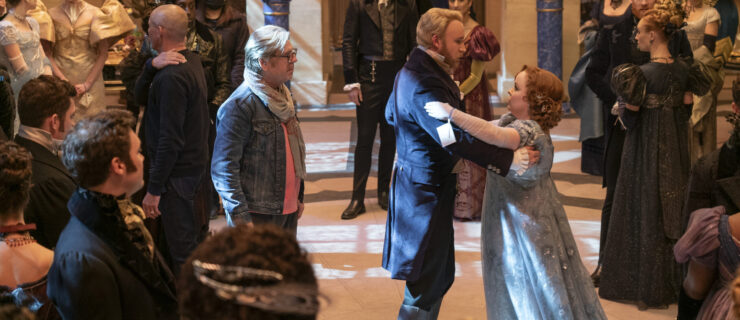It's About Time: Mastering The Time Step

You and hundreds of other dancers are waiting to be seen at an open call for a tour of A Chorus Line. Your outfit is perfect and you’re warmed up and ready to go. But you know the first thing the choreographer will ask to see—before you can even show off your jazz chops—is the essential tap trademark: the time step.
Stomp, hop, step, flap, step; stomp, hop, step, flap, step
. Tap dancers would have no problem pulling one off with precision and accuracy. But what if you’re a Broadway baby, a contemporary diva or a prima ballerina? If tap isn’t your focus, the time step is a simple yet crucial move you’ll want to master. The time step can show up at any musical theater audition and Lainie Munro, a director, choreographer, performer and teacher at NYC’s Broadway Dance Center, says it’s the number one step you need to know. “Every big tap musical audition—No, No, Nanette, Crazy for You—starts with a time step,” she says.
Back in Time
The time step can be traced back to the vaudeville era in the late 19th and early 20th centuries, when it was used as the introduction to improvisations. Dancers would repeat the time step, usually for six measures of music, and then perform two measures of improvised steps choreographed in the moment. The time step reached a peak in popularity in the 1920s and 1930s, when tap dancers began performing with large orchestras and needed a way to communicate tempo to the musicians.
During these decades, when tap dance was a prominent form, each dancer developed unique variations on the time step to show off his or her individuality. For example, the legendary tap dancer Bill “Bojangles” Robinson used a shuffle, hop, flap, flap, step as the time step in one of his signature routines. There were also variations stemming from tap’s diverse origins. In Beverly Fletcher’s Tapworks: A Tap Dictionary and Reference Manual, the author explains that white tap dancers tended to perform the time step on the balls of their feet, like Irish dancing, whereas black performers used a more flat-footed technique. This, along with individual takes on the time step, led to the assortment we have today.
Most contemporary tap dancers use recorded music, so today the time step is rarely used to set tempo, but the step still retains the same basic principles upon which it was built, consisting most frequently of two measures, repeated three times.
Time Step Basics
Ready to learn? Visit dancespirit.com//videos to see American Tap Dance Foundation teacher Courtney Runft demonstrating the time step.
The simplest time step, a single basic, consists of five moves: stomp, hop, step, flap, step. Most often it begins on count eight, which fits nicely with the common 4/4 time signature. In 4/4, there are four beats per measure and the fourth note gets the beat; in two measures there are eight counts with an emphasis on the fourth and eighth beats, which makes those beats the natural starting places for a time step.
Shea Sullivan, a NYC-based choreographer and dance teacher at Broadway Dance Center, is constantly trying to find the best ways to demonstrate the basic time step so dancers can feel it in their bodies. “I say it and do it simultaneously,” she explains.
Munro suggests a simple ditty to remember the rhythm. Sing the phrase after you stomp on eight, and the steps will fall into place. The phrase is, Thanks for the buggy ride. For your feet this means, hop, step, flap, step, stomp. “If you can remember that, then you’ve got it,” Munro says.
Variations on the Theme
You may also encounter one of the time step’s many variations. Traveling time steps, cramp roll time steps, wing time steps—even the traditional time step has several forms: single basic, double basic (which replaces the first step with a flap), triple basic (which replaces that flap with a shuffle step) and double triple basic (which adds another shuffle step before the final step stomp).
The beginning of the time step can also vary. Instead of a stomp you may be asked to do a stomp spank or even a shuffle. And some people prefer to start the time step on count one rather than on count eight.
Arm Yourself!
Time step arms can vary, too. “It’s a taste thing and it depends on who’s choreographing,” says Megan Bartula, a trained competition dancer from Rochester Hills, MI, who now takes class at Steps on Broadway in NYC. “I’ve seen so many different arms. The studio I grew up in had very specific time step arms. We did jazz hands that bent up at the elbows so that our hands were right in front of our shoulders on the stomp and then on the hop they were down straight until the next stomp.”
At an audition, pay careful attention to the arm placement demonstrated. “42nd Street has very specific arm choreography,” Munro says. “When the curtain flies up you see the double time step—arms and legs—and it’s very stylized.” If the audition demonstration features loose arms that seem to go with the flow of the movement, let your arms swing back and forth naturally, in time with the rhythm of your feet. “They should hang,” Munro says. “Every time your feet come forward, the arms come forward.”
Simple yet fundamental tap skills like the time step are important for dancers auditioning outside of their discipline. Knowing that you’re able to execute the step accurately will give you confidence in an audition setting, helping you stand out in a crowd and make the cut!
To watch American Tap Dance Foundation teacher Courtney Runft demonstrate a time step, go to
dancespirit.com//videos
NYC-based freelance writer Brynn Wein Shiovitz has an MA in Performance Studies from New York University. She dances with Tap Olé Dance Company and teaches at the Bronx’s Mind Builders Creative Arts Center.



